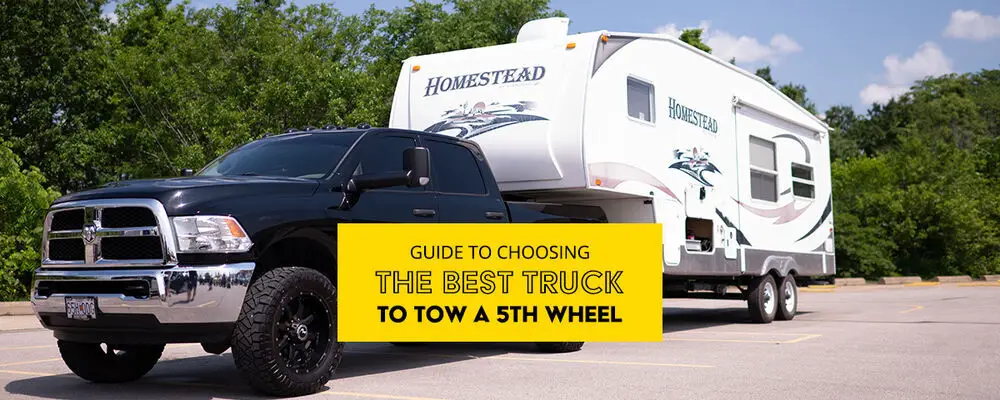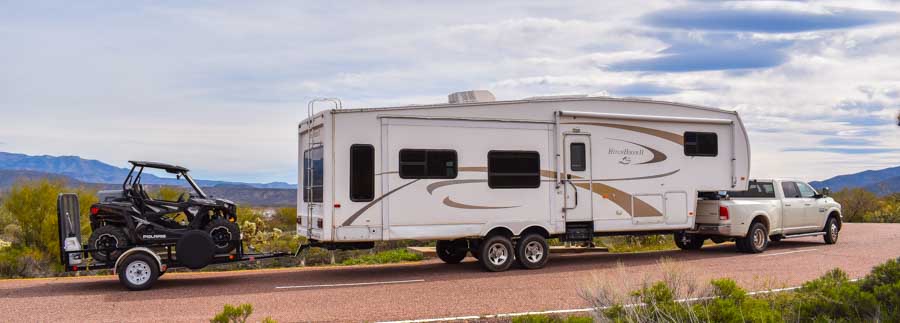Double towing with a 5th wheel involves towing a second trailer behind the 5th wheel trailer. This practice is legal in some states but restricted or prohibited in others due to safety concerns.
Those who plan to engage in double towing should familiarize themselves with relevant regulations and ensure they have the necessary equipment to do so safely. 5th wheel double towing can offer added convenience for those who need to transport multiple trailers, such as RV enthusiasts or drivers hauling recreational equipment.
However, it is crucial to understand the rules and guidelines in your area before attempting this practice to avoid legal issues and ensure safety on the road. We will explore the ins and outs of 5th wheel double towing, covering regulations, equipment requirements, and essential safety tips to consider for a smooth and secure towing experience.

Credit: www.quora.com
Factors To Consider Before Double Towing
Before double towing with a 5th wheel, consider individual state laws and regulations regarding towing multiple trailers. Ensure the towing vehicle can handle the additional weight, and practice maneuvering in open areas to get comfortable with the setup. Stay safe by using proper hitching equipment and adhering to speed limits.
Setting Up Your Double Towing Rig
Introductory Paragraph Choosing the Right HitchChoosing The Right Hitch
- Select a heavy-duty fifth-wheel hitch for your primary trailer.
- Choose a sturdy ball hitch for the secondary trailer.
Properly Aligning The Trailers
- Ensure the primary trailer is directly connected to the hitch.
- Align the secondary trailer using a straight line from the hitch.
Ensuring Adequate Visibility
Install extended mirrors to see both trailers while driving.
Balancing the LoadBalancing The Load
| Primary Trailer | Secondary Trailer |
|---|---|
| Distribute weight evenly to avoid swaying. | Position heavier items closer to the front. |
Safe Driving Techniques For Double Towing
When it comes to double towing, safety should always be a top priority. Whether you’re hauling a 5th wheel trailer behind your RV or another trailer behind your truck, proper driving techniques can help ensure a safe and smooth journey. By maintaining proper speed, allowing for extra stopping distance, anticipating turns and lane changes, and adjusting to weather and road conditions, you can minimize risks and enjoy a stress-free towing experience. In this article, we will discuss these safe driving techniques in detail.
Maintaining Proper Speed
One of the key factors in safe double towing is maintaining a proper speed. It’s important to always follow the speed limits and drive at a speed that is suitable for the road conditions. Driving too fast can lead to loss of control, especially when navigating turns or encountering sudden obstacles. On the other hand, driving too slow can impede the flow of traffic and create hazardous situations. Stay mindful of your speed and adjust accordingly to ensure the safety of yourself and other drivers on the road.
Allowing For Extra Stopping Distance
When towing two trailers, the overall weight and length of your rig increase, impacting the stopping distance required. It’s crucial to allow for extra stopping distance to compensate for this additional weight. Increase the following distance between your vehicle and the one ahead of you, giving yourself enough time to brake gradually and safely. Remember that double towing requires a greater stopping distance than regular driving, so always factor this into your driving strategy.
Anticipating Turns And Lane Changes
Double towing requires extra attention when making turns and lane changes. Due to the extended length of your rig, you need to plan your moves well in advance. Before turning, make sure to signal early and check your blind spots carefully. Take wider turns to avoid cutting corners and allow ample space for both trailers to safely navigate the maneuver. When changing lanes, always use your mirrors and signal clearly to inform other drivers of your intentions. By anticipating these maneuvers, you can maintain control and minimize the risk of accidents.
Adjusting To Weather And Road Conditions
Weather and road conditions can significantly affect your double towing experience. Rain, snow, wind, and uneven surfaces can all pose challenges that require careful adjustment. Reduce your speed when faced with adverse weather conditions to maintain control over your rig. Pay attention to road signs and warnings, as they can alert you to potential hazards. If the road is slippery, drive cautiously and avoid any sudden maneuvers that could cause skidding or sliding. By adapting to the current conditions, you can ensure a safer and more enjoyable double towing journey.
Tips For Maneuvering Double Trailers
When it comes to double towing with a 5th wheel, maneuvering two trailers can be challenging. However, with the right tips and techniques, you can navigate your way smoothly. Below are essential tips for maneuvering double trailers to help you handle backing up, making turns, and changing lanes confidently.
Backing Up
Backing up with double trailers requires precision and patience. Ensure the alignment of both trailers before beginning the maneuver. Use small steering inputs and constant vigilance to avoid jackknifing the trailers. Consider using a spotter to guide you while reversing to minimize blind spots and ensure a safer backing up process.
Making Turns
When making turns with double trailers, plan your route carefully and choose wider turns to accommodate the extended length. Keep a slower speed to maintain control and aim for a wider swing to prevent the trailers from cutting corners too tightly. Practice anticipating the path of both trailers to execute turns smoothly and avoid any potential collisions or overturning.
Changing Lanes
Changing lanes with double trailers requires heightened awareness and caution. Use your mirrors and turn signals to indicate your intentions clearly to other drivers. Ensure there is sufficient space in the adjacent lane before initiating the lane change. Gradually merge and maintain a constant speed to allow the trailers to adjust smoothly and avoid sudden swaying.
Important Safety Practices
Regular Trailer Maintenance
Regular maintenance of your trailers is crucial to ensure safe double towing. Inspect your trailers for any signs of wear and tear, such as rust, damaged lights, or loose bolts. Checking the brakes, lights, and tire condition should be part of your routine maintenance schedule.
Securing Your Load
Properly securing your load ensures that it stays in place during transit. Use strong, reliable tie-down straps and chains to secure your cargo. Double check that everything is secured before setting off on your journey.
Using Safety Chains And Breakaway Systems
Always use safety chains to connect your trailers, and ensure they are crossed to form a cradle underneath the hitch. Additionally, utilize a breakaway system that activates the trailer brakes in the event the trailers become disconnected from the towing vehicle.
Monitoring Tire Pressure
Monitoring tire pressure is essential for safe double towing. Make sure to regularly check the tire pressure of all your trailers, including the spare tires. Properly inflated tires are crucial for maintaining stability and maneuverability while on the road.

Credit: roadslesstraveled.us
Legal Considerations And Regulations
When it comes to 5th wheel double towing, it’s important to be aware of the legal considerations and regulations that come into play. State and local laws, as well as permits and licensing requirements, vary across different regions. Understanding and adhering to these regulations is crucial to ensure a safe and compliant journey.
State And Local Laws
State and local laws play a significant role in determining whether or not you can engage in 5th wheel double towing. These laws can vary widely, so it’s essential to research and familiarize yourself with the specific regulations of the state and local areas you plan on traveling through.
Some states may have restrictions on the overall length of your towing setup, while others may impose weight limits. It’s crucial to respect these laws as they are in place to maintain road safety and prevent accidents.
For example, in California, there are specific guidelines that dictate the size and weight limitations for double towing. The combined length of your primary towing vehicle, fifth wheel, and second towed vehicle may not exceed a certain length.
Understanding these state and local laws not only keeps you on the right side of the law but ensures you can navigate through each area with ease and reduce the risk of any legal problems.
Permits And Licensing Requirements
In addition to state and local laws, permits and licensing requirements may also be necessary for 5th wheel double towing. These permits are usually obtained from the appropriate transportation authorities and grant you permission to operate your setup within a specific jurisdiction.
The requirements for obtaining permits can vary, so it’s important to check with the relevant authorities in each state or area you plan on traveling through. Some jurisdictions may require you to have specific endorsements on your driver’s license, such as a double trailer endorsement.
Moreover, it’s worth noting that permits may have associated costs that you need to consider in your budget. These costs can vary depending on the duration of your trip and the jurisdictions you plan on passing through.
By ensuring you have the necessary permits and licenses, you can travel confidently knowing you are compliant with the law and prepared to handle any potential roadblocks along the way.

Credit: roadslesstraveled.us
Frequently Asked Questions For 5th Wheel Double Towing
What Is Double Towing And How Does It Work?
Double towing, also known as tandem towing, is the practice of towing two trailers behind a single vehicle. It involves a primary trailer attached to the vehicle’s hitch and a secondary trailer connected to the primary trailer. This setup requires specific regulations and considerations for safe and legal operation.
Is Double Towing Legal In All States?
No, double towing regulations vary by state, and it’s crucial to be aware of the specific laws in each area. Some states prohibit double towing altogether, while others have restrictions on the length of the entire rig or the type of roads where double towing is permitted.
Always research and adhere to local regulations when double towing.
What Type Of Vehicles Are Suitable For Double Towing?
Vehicles used for double towing must have sufficient power, stability, and braking capacity to safely manage the additional weight and length of two trailers. Typically, larger trucks, SUVs, and RVs are suitable for double towing, but it’s essential to consult the manufacturer’s towing guidelines and consider the terrain and road conditions where the towing will occur.
Conclusion
Double towing with a 5th wheel can provide practicality and versatility for RV enthusiasts. By understanding the regulations, safety measures, and equipment requirements, RVers can enjoy the freedom of bringing along additional cargo or a second trailer. Whether it’s for extended road trips or hauling additional gear, double towing with a 5th wheel opens up a world of possibilities for the adventurous traveler.
So, if you’re up for the challenge, go ahead and explore the double towing experience!